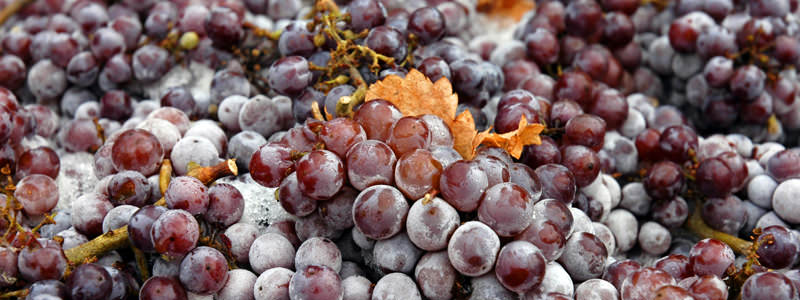One of the main wines drunk around the holidays is ice wine, a sweet, syrupy libation that’s the perfect cap to the end of a meal. And its sweetness is definitely gaining in popularity, especially among the portion of drinkers who enjoy sweeter wines like Riesling and Moscato. But unlike these wines that are made from grapes harvested during the normal fall season, ice wine grapes don’t usually come off of the vine until around December, and even into January and February, when the temperature finally drops to extreme lows, and the grapes have reached their ideal frozen state for producing the delicious liquid.
Ice wine first gained prominence in Germany, where even today the most expensive ice wines are produced. It’s believed that the Germans stumbled upon this wine in 1830, when, during what was anticipated to be a very harsh winter, many of the vintners decided it’d be a good idea to leave some of the grapes unpicked on the vine in order to feed the animals in the field throughout the season. When the first frost hit, the vintners noticed the juice inside the grapes became even sweeter than normal, so they decided to pick and press these grapes instead – sorry animals – allowing the sweet juice to ferment, resulting in the first ice wine.
Making ice wine is a precarious endeavor for winemakers, as they’re at the whims of mother nature and often must pick at a moment’s notice. But they claim the uncertainty is worth it, because waiting allows for only the best fruit to still remain on the vine by the time the first frost hits, allowing for the sweetest fruit to be present when it’s time to make the delicious wine. This waiting also results in scarcity of fruit, resulting in limited quantities of ice wine, which often causes it to be quite expensive.
What causes ice wine to be so sweet is the act of freezing in the first place. When the grapes freeze, the sugars and dissolved solids do not, while the water inside does, resulting in an extremely concentrated and sugary liquid that emerges when the grapes are ultimately pressed.
This act of freezing the grapes in order to extract the sweet juice of course begs the question of why the vintners leave the fruit on the vine, waiting for the first frost, instead of picking ice wine grapes at the same time of harvest as every other grape, and then simply throwing them in a freezer to achieve the same results. The answer, for the most part, is tradition, though some winemakers do pick the grapes and then freeze them in a freezer, though if this method is used, the wine it creates is not allowed to technically be called ice wine. Winemakers who use this method have therefore gotten creative with the names they call the resulting liquid, using names such as iced wine, adding a d to the end or icebox wine to signify the grapes were not frozen naturally.
No matter how the wine is ultimately made, the result is liquid gold, some of the finest dessert wine in the world that’s perfect for toasting the holiday season.
Header image via Shutterstock.com

